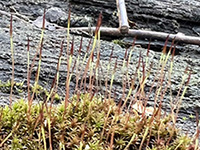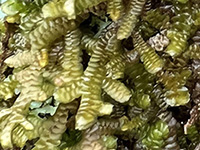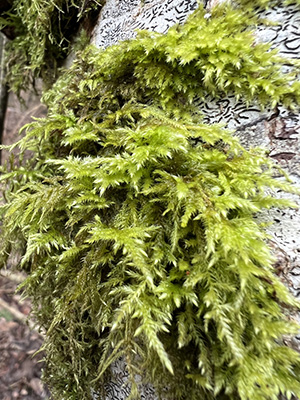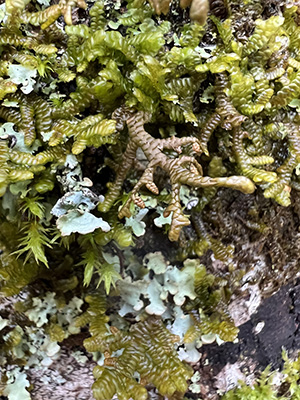Stoney Creek Trail — Abbotsford, BC
Mosses and Liverworts
MOSSES and Liverworts are small, primitive plants that have root-like filaments called rhizoids rather than roots. They absorb water and nutrients through their leaves which are only one cell thick. They reproduce by spores rather than seeds. Like mushrooms, they can be difficult to identify correctly.
HORNWORTS look much like liverworts but are in a different division (not related).

MOSS SPORES form in a capsule on the tip of a thin, upright stalk called a sporophyte and are released slowly in the wind.
The lower part of a moss, made up of leaves and stems, is called a gametophyte. The leaves have radial or spiral symmetry and can be almost any shape. The stems may be simple or branched, upright or lying flat, and are attached to rhizoids that anchor them to surfaces.

LIVERWORT SPORES form in a capsule that is usually held on a thicker, fleshy stalk and are expelled all at once. The spores germinate to produce ribbon-like (thallose) or leafy (foliose) plants. Most liverworts are leafy, having stems with two rows of very small, ranked leaves that are often rounded and overlapping, like shingles. They look much like mosses.
The thallose type are flat like a green pancake and do not have stems or leaves.
.jpg)
Feathered neckera
(Neckera pennata)
.jpg)
Tree ruffle liverwort
(Porella navicuaris)

Rough-stalked feather
(Brachythecium hylotapetum)
 etc. on dead branch above SB 01 copy.jpg)
Genus Pulvigera
.jpg)
Joint-tooth moss
(Bryopsida)

A mixture of lichens, liverworts
and mosses on an alder tree
.jpg)
Rough-stalked Feather
(Brachythecium rutabulum)
 copy.jpg)
Juniper haircap
(Polytrichum juniperinum)
.jpg)
Fragile fork-moss
(Dicranum tauricum)
-cropped copy.jpeg)
Apple
(Bartramia pomiformis)
.jpg)
Common feather-moss
(Kindbergia praelonga)
.jpg)
Genus Homalothecium
(Homalothecium fulgescens)
 copy.jpg)
Pincushion
(Dicranoweisia cirrata)